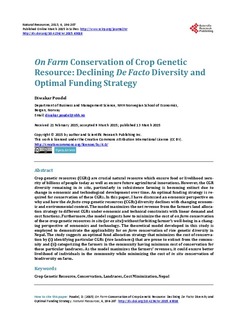| dc.contributor.author | Poudel, Diwakar | |
| dc.date.accessioned | 2015-05-11T11:35:38Z | |
| dc.date.accessioned | 2015-05-12T06:41:41Z | |
| dc.date.available | 2015-05-11T11:35:38Z | |
| dc.date.available | 2015-05-12T06:41:41Z | |
| dc.date.issued | 2015 | |
| dc.identifier.citation | Natural Resources 2015, 6:196-207 | nb_NO |
| dc.identifier.issn | 2158-7086 | |
| dc.identifier.uri | http://hdl.handle.net/11250/283524 | |
| dc.description | -Copyright © 2015 by author and Scientific Research Publishing Inc.
This work is licensed under the Creative Commons Attribution International License (CC BY). | nb_NO |
| dc.description.abstract | Crop genetic resources (CGRs) are crucial natural resource which ensure food or livelihood security of billions of people today as well as ensure future agricultural innovations. However, the CGR diversity remaining in in situ, particularly in subsistence farming is becoming extinct due to change in economic and technological development over time. An optimal funding strategy is required for conservation of these CGRs. In this paper, I have discussed an economic perspective on why and how the de facto crop genetic resources (CGRs) diversity declines with changing economic and environmental context. The model maximizes the net revenue from the farmers land allocation strategy to different CGRs under economic and technical constraints with linear demand and cost functions. Furthermore, the model suggests how to minimize the cost of on farm conservation of these crop genetic resources in situ (or ex situ) without forfeiting farmer's well-being in a changing perspective of economics and technology. The theoretical model developed in this study is employed to demonstrate the applicability for on farm conservation of rice genetic diversity in Nepal. The study suggests an optimal fund allocation strategy that minimizes the cost of conservation by (i) identifying particular CGRs (rice landraces) that are prone to extinct from the community and (ii) categorizing the farmers in the community having minimum cost of conservation for those particular landraces. As the model maximizes the farmers' revenues, it could ensure better livelihood of individuals in the community while minimizing the cost of in situ conservation of biodiversity on farm. | nb_NO |
| dc.language.iso | eng | nb_NO |
| dc.publisher | Scientific Research Publishing Inc. | nb_NO |
| dc.rights | Navngivelse 3.0 Norge | * |
| dc.rights.uri | http://creativecommons.org/licenses/by/3.0/no/ | * |
| dc.subject | crop genetic resources | nb_NO |
| dc.subject | conservation | nb_NO |
| dc.subject | landraces | nb_NO |
| dc.subject | cost minimization | nb_NO |
| dc.subject | Nepal | nb_NO |
| dc.title | On Farm Conservation of Crop Genetic Resource: Declining De Facto Diversity and Optimal Funding Strategy | nb_NO |
| dc.type | Journal article | nb_NO |
| dc.type | Peer reviewed | nb_NO |
| dc.date.updated | 2015-05-11T11:35:37Z | |
| dc.source.pagenumber | 196-207 | nb_NO |
| dc.source.volume | 2015 | nb_NO |
| dc.source.journal | Natural Resources | nb_NO |
| dc.source.issue | 6 | nb_NO |
| dc.identifier.doi | dx.doi.org/10.4236/nr.2015.63018 | |
| dc.identifier.cristin | 1241041 | |

